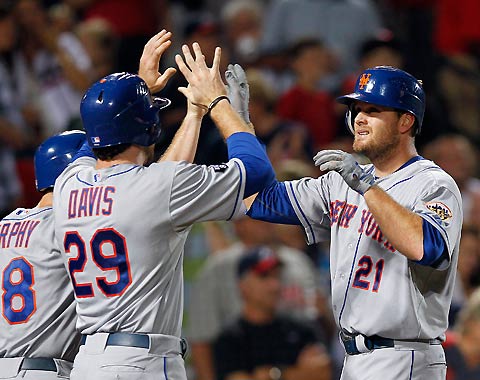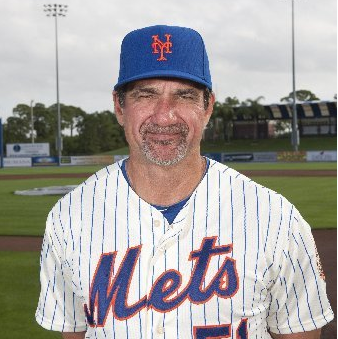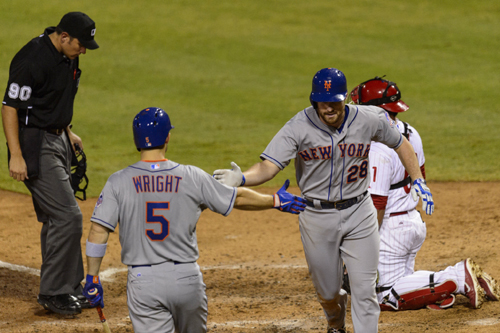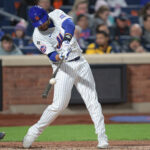There was a nice Q&A over on Metsblog with Mets’ hitting coach Dave Hudgens, who gave a little insight into what the Mets’ hitting philosophy is. Hudgens also spends a little time talking about Ike Davis and his recent woes, and seems pretty confident that he can turn things around.
Matt Cerrone highlights one quote in particular from Hudgens: “We want hitters to look for their strength, especially early in the count, from the first pitch to the fifth pitch, to the sixth pitch, when we’re in hitters counts we want to be aggressive on our pitch,” he said. “I mean, obviously, I’d rather see a double in the gap with two guys on than a walk. But, there’s sometimes during the game, David Wright‘s not going to get his pitch. I would rather him take the walk as opposed to swing at a marginal pitch and hit into a double play.”
I have one main concern with this quote—the player who qualified with the most pitches per plate appearance (P/PA), in 2013, was Mike Napoli, with 4.59. So nobody averaged five pitches per plate appearance last year. I was surprised to see that Eric Young Jr was the Mets’ player with the fourth-highest P/PA (minimum 100 games played). Young saw 3.74 pitches per plate appearance in 2013, which ranked him behind only Wright, Ike Davis, and Lucas Duda. I am starting to see why the Mets are enamored with him hitting leadoff—but he has to show me he can get on base more before I jump on board.
Here is my major issue with what Hudgens said—why is Hudgens talking about the fifth and sixth pitch in an at-bat? Simple math tells you that by the time a hitter see five or six pitches, they will have two strikes and naturally be more defensive, not aggressive. It’s impossible to get to the sixth pitch in a count without two strikes on the hitter.
Pitches seen and success varies greatly. Curtis Granderson saw just under four pitches per plate appearance in 2013 (3.99). Chris Young, Davis and Duda also averaged over four pitches per plate appearance. What do these four guys have in common? All four of them have a tendency to strike out.
 The terms “discipline at the plate” and “patience at the plate” come up quite often when discussing hitters’ approaches at the plate—especially if you are a Mets fan. This notion that the organization is teaching their hitters to be more patient is a questionable one to say the least.
The terms “discipline at the plate” and “patience at the plate” come up quite often when discussing hitters’ approaches at the plate—especially if you are a Mets fan. This notion that the organization is teaching their hitters to be more patient is a questionable one to say the least.
The two terms sound like they mean the same thing, but actually are quite different.
Patience refers to working a pitcher, seeing all his pitches, and waiting for the right pitch to jump on. The hitter basically is waiting for the pitcher to make a mistake. Some hitters excel using this strategy, while others flop. Patience naturally leads to a higher propensity to strike out, since you are taking at-bats into deep counts. The count itself is in the pitcher’s favor—three strikes versus four balls—which is more likely to occur?
You have to have an incredible amount of skill and mental toughness to hit using the strategy of patience. I would argue that this skill cannot even be taught. Being patient forces hitters to hit from behind in the count often, which also contributes to higher strikeout rates for patient hitters. So while patient hitters tend to pile up the walks, they also pile up the strikeouts. You either have what it takes to hit using this strategy, or you don’t.
Patience should be reserved for top-of-the-order hitters. The batting lineup is designed the way it is for a reason and is technically a division of labor. The top two hitters’ jobs are to work the pitchers and get on base. The middle-of-the-order hitters’ jobs are to drive in the top-of-the-order guys. The tail end of the lineup is generally reserved for defensive minded players, so not much is expected.
You cannot force your 3-4-5 hitter to be patient at the plate. Patience is not a strategy that can be forced on every player and that is why speed is not the only determining factor for guys hitting at the top of the order. Those middle-order hitters should show good plate discipline, but not be patient.
Discipline at the plate is the ability of the hitter to lay off pitches that are close, only swinging at pitches in the strike zone. This can be taught to hitters, and as they gain more experience at the plate, their plate discipline will improve. Of course, as with everything else, some hitters are better than others in this area.
So which is better to have, strike-zone discipline or patience at the plate?
The answer is that it depends on what slot in the batting order the hitter is in. For my one and two hitters, I would prefer them to be more patient. I want them to get on base as much as possible, see as many pitches as possible so the heart of my order gets a good look at what the pitcher is bringing. This also gets the pitcher tired. We know being patient comes with a higher propensity to strike out, but it’s a necessary evil.
The rest of the guys in the batting order should have good plate discipline. This means that they aren’t swinging at pitches out of the strike-zone, and not giving away at-bats.
The Mets were tied for third in the major leagues with strike outs in 2013—1384 total. That number was good for one in every four at-bats. The Mets also had the sixth-lowest OBP in baseball last season (.306). They gave away a ton of at-bats.
One could argue that the Mets are being overly patient, which is not attributing to the team getting on base more, or scoring more runs. They should focus on being more disciplined, which means not chasing balls out of the zone, and not patience, which has attributed to higher strike out rates and lower on base percentage.

















